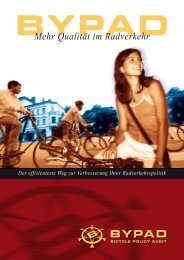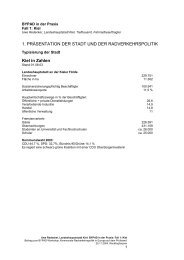Annex I: Literature search bicycle use and influencing ... - ByPAD
Annex I: Literature search bicycle use and influencing ... - ByPAD
Annex I: Literature search bicycle use and influencing ... - ByPAD
You also want an ePaper? Increase the reach of your titles
YUMPU automatically turns print PDFs into web optimized ePapers that Google loves.
We find the highest number of killed cyclists in Germany, the highest risk per capita in<br />
the Netherl<strong>and</strong>s <strong>and</strong> Belgium. The highest risk to get killed as a cyclist per distance<br />
traveled is found in Portugal <strong>and</strong> Spain. The first measure (number of killed cyclists) does<br />
not take into account the number of inhabitants nor the amount of cycling. The second<br />
measure accounts for population, but still doesn’t account for the amount they cycle. The<br />
third measure takes also into account the amount of cycling that is done in a particular<br />
country. We find that in general countries where people cycle a lot, the risk of getting<br />
killed in traffic as a cyclist is lowest (fig. @@). Countries with little cycling have the<br />
highest accident risks. Jacobsen (2003) called this (common) phenomenon ‘safety in<br />
numbers’. The more prevalent a phenomenon is (in this case: the more people cycle) the<br />
less unsafe it becomes. A general trend of decreasing risk with increasing exposure is<br />
found in several studies (Jacobsen, 2003; Van Hout et al, 2005; Leden et al, 2000;<br />
Ekman, 1996; Busi, 1998; Jonsson, 2005).<br />
@@insert fig (Van Hout (2007), p. 29)<br />
Several studies compare the risks cyclists face with the risks faced by car occupants<br />
(@@ref@@). When risks are calculated as the number of victims per kilometer traveled,<br />
the accident risk of cyclists is usually significantly higher then that of car occupants.<br />
There are two main explanations to this. Firstly cyclists are far more vulnerable than car<br />
occupants. Secondly cyclist trips are shorter. Therefore they are more likely to be found<br />
in built up areas where more conflicts occur. When compensated for travel on safe<br />
highways (which is prohibited for cyclists) the difference between risk for cyclists <strong>and</strong> risk<br />
for car occupants diminishes or even disappears (@@ref@@).<br />
How comes then that cycling risks are estimated far worse than risks faced as a car<br />
driver? When risks are small (<strong>and</strong> the risk of getting injured in a traffic accident is small,<br />
no matter which means of transportation) people tend to base their judgment on the<br />
possible outcome of the accident. By incorporating both perceived accident probability<br />
<strong>and</strong> perceived severity, Nol<strong>and</strong> (1995) found that perceived probability was not a<br />
significant predictor for cycle <strong>use</strong>, while the perceived severity is. De Blaeij <strong>and</strong> van<br />
Vuuren () state that most people simply lack intuition to estimate very small probabilities<br />
in an adequate fashion. With small probabilities individuals base their decisions on the<br />
possible outcomes rather than on the probabilities involved. They also refer to a study by<br />
Liu <strong>and</strong> Hsieh (1995) who concluded that individuals will overestimate the risks of highly<br />
publicized events. So telling all the time how dangerous cycling is will increase the<br />
perceived risk.<br />
Another way of looking to injury risk is the risk someone poses to other road <strong>use</strong>rs. When<br />
the risk of accident involvement (no matter the outcome) is studied, we find that car<br />
drivers are, per km driven, more likely to be involved in a traffic accident than cyclists<br />
(Van Hout, 2007). In accidents involving cars <strong>and</strong> cyclists, it will (almost) always be the<br />
cyclist who gets hurt. So it’s safe to conclude that cycling is somewhat unsafe (risk of<br />
getting injured), <strong>bicycle</strong>s as such pose little threat on others.<br />
@@Wardlaw resp. Krag nog invoegen@@<br />
1.2.3 Social equity<br />
Not everyone owns a car or is allowed to drive it. 21% of Europeans are children under<br />
18 who are unable to drive a car (beca<strong>use</strong> of the minimum driving age). Nevertheless<br />
everybody has the right of mobility, of participating in outdoor activities. When space is<br />
built to accommodate cars, this right is under pressure. Distances increase <strong>and</strong> walking<br />
or cycling are no viable options anymore. In that case the car-less are trapped at home<br />
(beca<strong>use</strong> public transportation often can’t provide a sufficient solution either), or at least<br />
dependent (<strong>and</strong> a burden?) on others (with a car). Less children are nowadays allowed to<br />
go to school in an independent way (in the UK 1 of 9 students travels to school<br />
Instituut voor Mobiliteit (IMOB) 9




